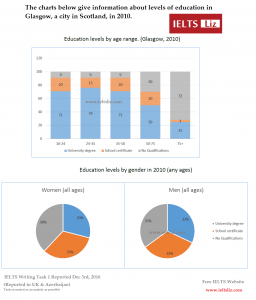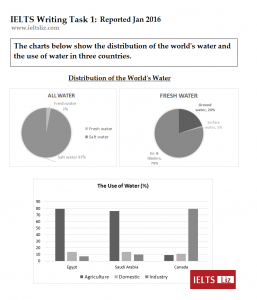Below is model answer for an IELTS bar chart and pie chart together for Writing Task 1. The sample answer is estimated at about band score 8. The sample answer contains some grammar errors – can you find them? Answers below.
IELTS Writing Task 1: Multiple Charts
December 2016, Sample Answer
Estimated at band score 8. It contains a few mistakes which is why it isn’t band 9. Can you find the mistakes?
The bar chart and pie charts illustrate the percentage of people in Glasgow having three levels of education (university, school and those with no qualifications) in 2010. Information is divided into five age groups in the bar chart and by gender in the pie charts.
Overall, the majority of people with university education were in younger age groups, while in the oldest age group most people did not have any qualifications. The proportions of men and women were similar and showed little different between the levels of education.
The percentage of people with university education was up to 76% in the younger three age groups compared to only 50% in those ages 50 to 75 and just 25% in those over 75. This trend was reversed in those with no qualifications (9% in younger people rising to 72% in the oldest age group). The figure for those with school education was relatively constant at around 20% but was as low as 3% in the over 75’s.
The proportion of men and women in each level of education was around one third with only a slightly difference of 3% in university graduates as well as those who didn’t have educational qualifications.
Words = 198
There are a few grammar mistakes in this writing. Can you find them? Answers provided below
Answers
Answers to Grammar Mistakes in the above sample answer – click below to open:
ANSWERS TO SPOT THE MISTAKES ABOVEParagraph 2: in younger age groups = in the younger age groups
Paragraph 2: little different = little difference
Paragraph 3: in those ages 50 to 75 = in those aged 50 to 75
Paragraph 4: a slightly difference = a slight difference
Paragraph 4: didn’t = did not
Main IELTS Pages
Develop your IELTS skills with tips, lessons, free videos and more.









